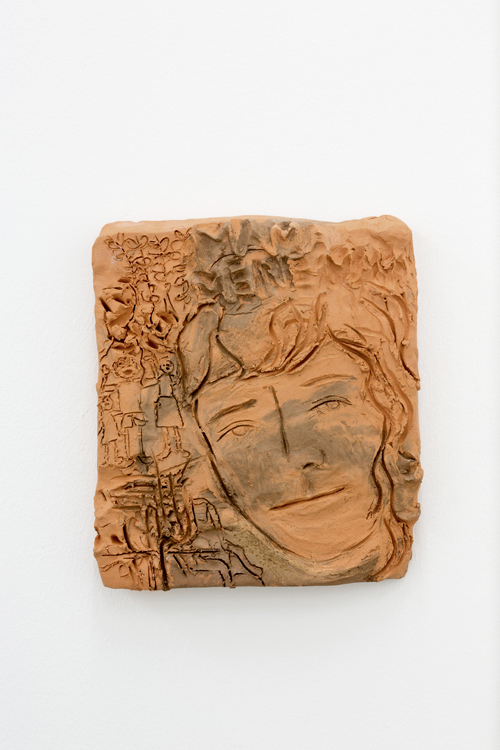Michaela Meise
Künstlerhaus Bethanien Berlin
Künstlerhaus Bethanien Berlin

Michaela Meise’s use of advertising, packaging and display cases in her exhibition Mothers initially felt like a return to 1960s Pop art. This impression, though, was disturbed by strangely antiquated ceramic portraits (Mothers, 2014). Pairing Pop with a seemingly ‘antique’ aesthetic, Meise shaped a formally contradictory dialogue, all within a resolutely feminist discourse.
At the entrance of the exhibition (held on the occasion of the Falkenrot Prize awarded to Meise in 2014), display cases from the series Gestelle (Stands, 2011) recalled both shop window displays and museum vitrines. In Schwarze Sonne (Black Sun, 2011), for example, Meise paired three books with three flowers. These flowers gave the installation a ceremonial charge, knowingly distancing it both from ordinary consumer displays and from attempts to present artefacts in the purest way possible. The three books were the German, English and French editions of Julia Kristeva’s Black Sun: Depression and Melancholia (1987) which examines the links between melancholy, depression and creativity. The root of depression, the book claims, is non-acceptance of the separation from one’s mother, the anguish of a lost bond – and this separation is then worked through via the creative use of language.
For her Mothers series, Meise conducted interviews with 12 women and then made portraits of each of their mothers, women she had never met. She, rather clumsily, engraved the outlines of their imagined physiognomies onto wet clay, intent on identifying and empathizing with the daughters’ accounts. One is called Rita: short hair, slightly pinched mouth, prominent chin; to the left of her were two line drawings of children playing. In formal terms, the emotionally charged relief was something like a hybrid of the busts found on ancient coins and early drawings by Elizabeth Peyton. A portrait of the psychoanalyst and second-wave feminist Luce Irigaray created in the same way acted as a leitmotif for the Mothers series. Like Kristeva, Irigaray supplies cues for the issues Meise wished to address, as she talks in her writings about the task of ‘giving life back to the mother’. In our male-dominated capitalist society, Irigaray claims, the figure of the mother has for centuries been either ignored or constructed in line with male notions – which in turn has a lasting impact on the identities of their daughters, to this day.
The advertisements and packaging in the last room of the exhibition were presented simply but with obvious artistic treatment, as when she collaged six packs of tea on warmly radiant red paper for PG-Tips (2009). Instead of aiming to glamourize the unspectacular product in question, this approach sought to lovingly embed it in the context of everyday life. These advertising- and packaging-based works may have appeared rather one-sided compared to the rest of the show, but in correspondence with the other works they lent Meise’s art an added dimension, making the show seem both warm-hearted and objective. This allowed Meise to address feminist issues in a way that deftly combined conceptual tactics with various artistic techniques. Although her approach was palpably engaged, she deliberately avoided agitation and ideology – making this exhibition all the more appealing.
Translated by Nicholas Grindell















